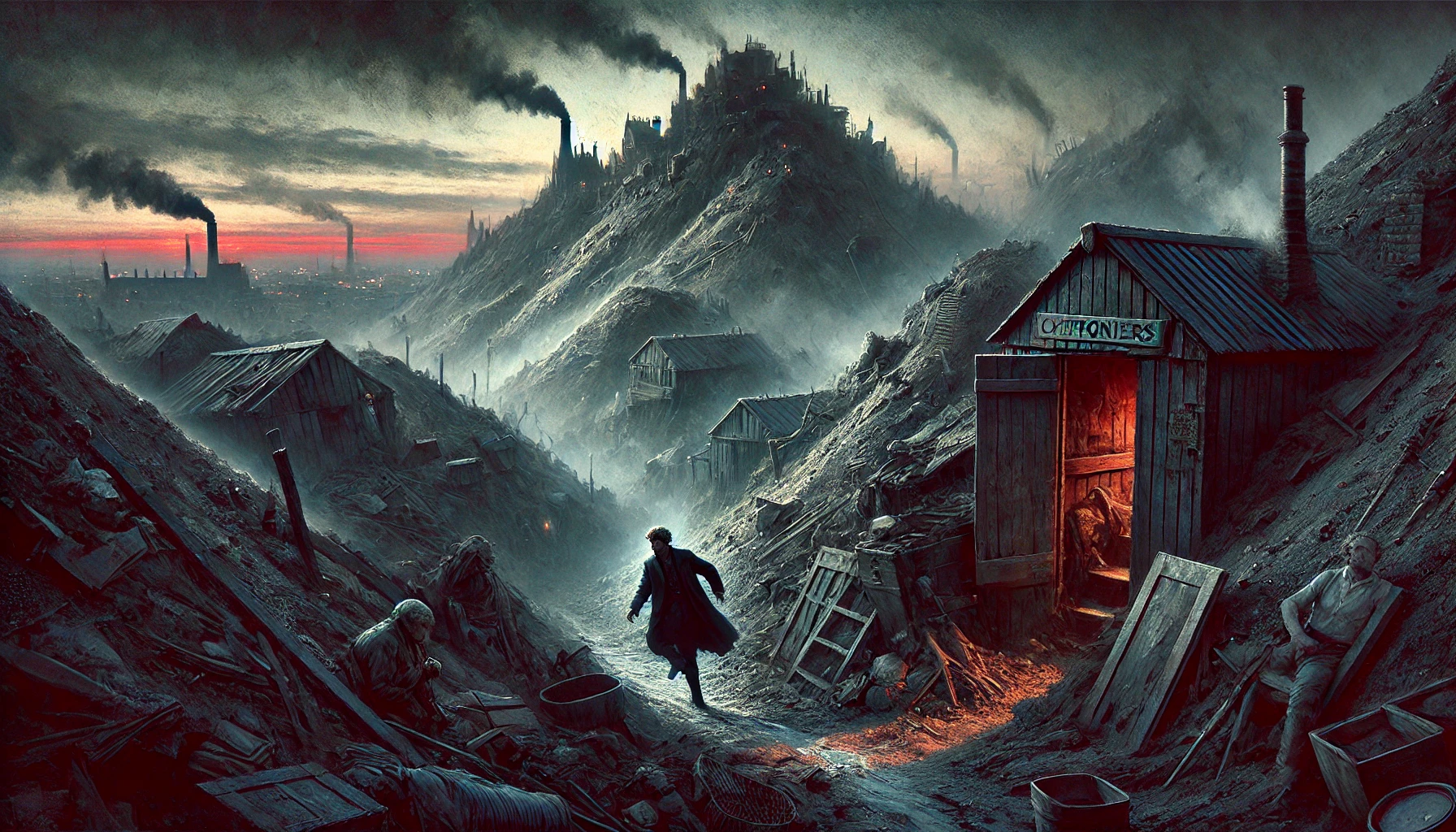The Invisible Man, written by H.G. Wells and published in 1897, is a seminal work of science fiction. It tells the story of Griffin, a scientist who discovers the secret to invisibility but soon becomes consumed by his own power and isolation. The novel explores themes of isolation, identity, and the potential consequences of unchecked scientific ambition. H.G. Wells, often called the “father of science fiction,” uses Griffin’s descent into madness to reflect on the darker aspects of human nature.
Plot Summary
The snow swirled around the quiet village of Iping as a stranger, covered head to toe in heavy clothing, arrived at the Coach and Horses inn. His face was entirely obscured by thick bandages, and he wore large blue-tinted spectacles. Mrs. Hall, the innkeeper, showed him to his room, though his strange appearance and abrupt manner made her uneasy. She assumed he had suffered some terrible accident. The stranger kept to himself, rarely speaking except to request privacy and food, and never removed his layers of clothing, even in the warmth of the fireplace. His behavior soon aroused curiosity and suspicion among the villagers.
Griffin, as the stranger is later revealed to be, had once been a promising scientist. Fascinated with the interplay of light and physical objects, he discovered a method to render himself invisible. But his grand experiment quickly spiraled into a nightmare. The power to become unseen came at a cost—his body was permanently invisible, and the isolation that followed weighed heavily on him. Griffin had hoped his discovery would bring him fame and fortune, but instead, it plunged him into a dark, lonely existence. As the days passed in Iping, his paranoia grew. His supplies were running low, and he was desperate to reclaim the equipment he had left behind.
Meanwhile, Teddy Henfrey, a clock repairman, encountered the stranger and spread gossip about his bizarre appearance. Griffin’s growing unease turned into anger, and he took it out on the villagers. Mrs. Hall, puzzled by the strange happenings in her inn—objects moving by themselves, unexplained noises—confronted the stranger. Furious at being disturbed, Griffin revealed the terrifying truth: he was invisible. Shocked and terrified, the villagers retreated, spreading word of the mysterious “invisible man.”
Griffin’s secret was now exposed. Needing assistance, he coerced a local tramp, Mr. Marvel, into helping him retrieve his notebooks and scientific equipment from his old lodgings. Marvel, a weak and easily frightened man, reluctantly agreed, though he harbored thoughts of betraying Griffin. Together, they traveled to a nearby town where Griffin’s possessions were kept. However, as Marvel’s fear grew, he managed to slip away, taking the notebooks with him, hoping to profit from the strange man’s research. Enraged by this betrayal, Griffin chased after him, wreaking havoc in the streets and leaving a trail of destruction in his wake.
The police were soon alerted, and a manhunt for the invisible terror began. But how do you catch a man you cannot see? Griffin, feeling cornered and increasingly unhinged, found refuge in the home of Dr. Kemp, a former acquaintance from his university days. Dr. Kemp, who initially had no idea of Griffin’s transformation, was both fascinated and horrified as Griffin revealed the full extent of his experiments. Griffin explained his journey from a brilliant scientist to a hunted fugitive, detailing how he used his invisibility to commit thefts, cause chaos, and lash out at the world that now shunned him. He justified his violent actions with grandiose ideas of power, believing that invisibility gave him the right to control others without consequence.
Dr. Kemp, however, was appalled by Griffin’s lack of morality and the sheer coldness with which he spoke of terrorizing the townspeople. Kemp realized that Griffin’s descent into madness was complete. Knowing that Griffin posed a grave danger to society, Kemp secretly alerted the police while trying to keep Griffin calm and contained within his home.
The next morning, as Griffin plotted to unleash a “Reign of Terror” upon the world, the police surrounded Dr. Kemp’s house. But Griffin, with his ability to vanish into thin air, eluded them. Furious at the betrayal, Griffin vowed to kill Kemp and anyone who stood in his way. What followed was a tense and frantic chase across the town as Griffin hunted Kemp, while the townspeople and police worked together to track the invisible threat.
In his desperate pursuit of Kemp, Griffin’s madness intensified. His once sharp scientific mind was now consumed by blind rage and paranoia. Unable to hide forever, Griffin’s invisibility became his downfall. The villagers, armed with rudimentary tools and guided by the faint sounds of his movements, finally managed to corner him in a field. In the chaos of the confrontation, Griffin was struck down. His body, though invisible, was broken by the sheer force of the attack.
As Griffin lay dying, his invisible form gradually became visible once more. His skin, muscles, and bones slowly reappeared before the eyes of the astonished villagers, revealing a man no different from any other. The monstrous invisible figure that had haunted them was, in the end, just a man—an extraordinary man, but a man nonetheless.
With Griffin’s death, the terror that had gripped the village began to lift. Dr. Kemp, who had narrowly escaped his fate, reflected on the tragedy of Griffin’s life. Once a man of great intellect and ambition, Griffin had allowed his pursuit of knowledge to consume him entirely. His invisibility had stripped him not only of his physical presence but also of his humanity, leaving him isolated, fearful, and ultimately destroyed by his own creation.
In the end, Griffin’s story was not one of triumph but of hubris—of a man who sought to transcend the limits of nature and paid the ultimate price. The town of Iping returned to its quiet routine, but the memory of the invisible man lingered, a chilling reminder of the dangers of unchecked ambition and the fragility of the human spirit.
Main Characters
Griffin (The Invisible Man): Griffin is the protagonist of the novel, a brilliant but obsessive scientist who discovers a way to make himself invisible. Initially portrayed as a man driven by scientific curiosity, Griffin’s character unravels as he becomes increasingly erratic, violent, and consumed by his desire for power. His invisibility alienates him from society, ultimately leading to his downfall.
Dr. Kemp: Kemp is a former associate of Griffin, who represents a moral counterpoint to the Invisible Man’s growing megalomania. Unlike Griffin, Kemp values human life and community, and he becomes instrumental in organizing the efforts to capture Griffin when his violent tendencies become evident.
Mrs. Hall: The landlady at the Coach and Horses inn, where Griffin first arrives. She provides an early glimpse into Griffin’s suspicious and mysterious behavior. Her growing unease mirrors the mounting tension as Griffin’s secret begins to unfold.
Mr. Marvel: A tramp whom Griffin coerces into helping him with various tasks. Marvel represents the common man, caught up in the consequences of Griffin’s actions but not fully understanding the depth of his involvement until it’s too late.
Theme
Isolation and Alienation: Griffin’s invisibility isolates him from society, both physically and emotionally. His inability to connect with others once invisible serves as a metaphor for the alienation that often accompanies unchecked ambition. Griffin’s descent into madness is exacerbated by his growing loneliness.
The Corrupting Influence of Power: The novel explores how power, especially when unchecked or misused, can lead to corruption. Griffin’s invisibility gives him a sense of omnipotence, which in turn leads him to commit increasingly violent acts. Wells raises questions about the ethical limits of science and the dangers of playing god.
The Limits of Science: Griffin’s story is a cautionary tale about the dangers of scientific overreach. His discovery of invisibility is initially framed as a triumph of human ingenuity, but the novel quickly reveals the consequences of ignoring the ethical implications of such power.
Identity and the Physical Self: Throughout the novel, Griffin’s invisibility strips away his physical presence, which in turn begins to erode his sense of identity. The inability to see his reflection or be recognized by others leads to Griffin’s psychological unraveling, emphasizing how much of our identity is tied to our physical appearance.
Writing Style and Tone
H.G. Wells employs a straightforward yet descriptive writing style that combines elements of realism with the extraordinary. His attention to scientific detail grounds the story in a sense of plausibility, making Griffin’s transformation into the Invisible Man both eerie and believable. Wells uses precise language to evoke the cold, clinical nature of Griffin’s experiments while contrasting it with the emotional turmoil he experiences as the story progresses.
The tone of the novel shifts from mysterious and suspenseful to dark and ominous as Griffin’s true nature is revealed. Wells creates an atmosphere of tension, particularly in the scenes where Griffin’s presence is felt but not seen, heightening the reader’s sense of unease. The narrative often adopts a cautionary tone, reflecting Wells’ critique of the hubris that can accompany scientific advancement without moral consideration.
We hope this summary has sparked your interest and would appreciate you following Celsius 233 on social media:
There’s a treasure trove of other fascinating book summaries waiting for you. Check out our collection of stories that inspire, thrill, and provoke thought, just like this one by checking out the Book Shelf or the Library
Remember, while our summaries capture the essence, they can never replace the full experience of reading the book. If this summary intrigued you, consider diving into the complete story – buy the book and immerse yourself in the author’s original work.
If you want to request a book summary, click here.
When Saurabh is not working/watching football/reading books/traveling, you can reach him via Twitter/X, LinkedIn, or Threads
Restart reading!








